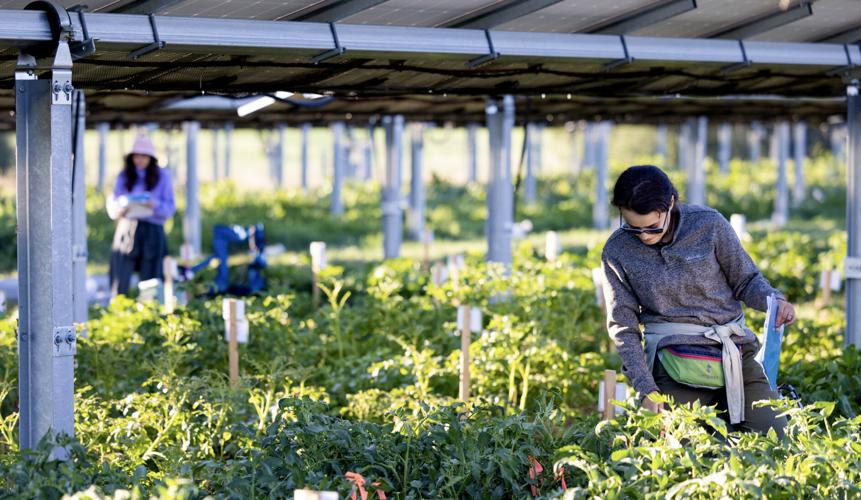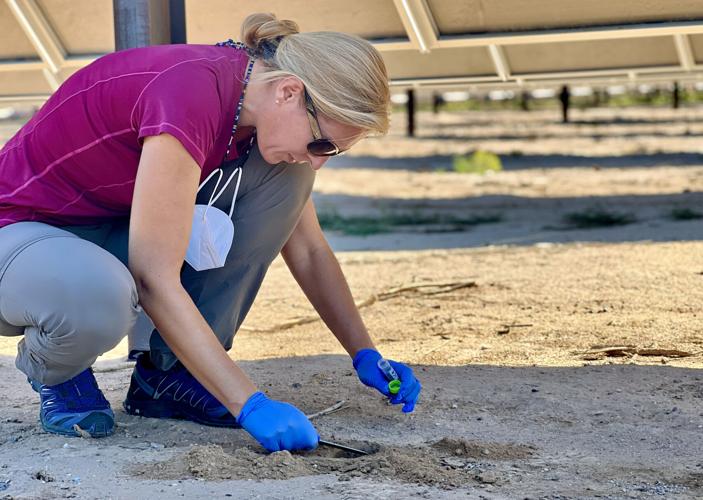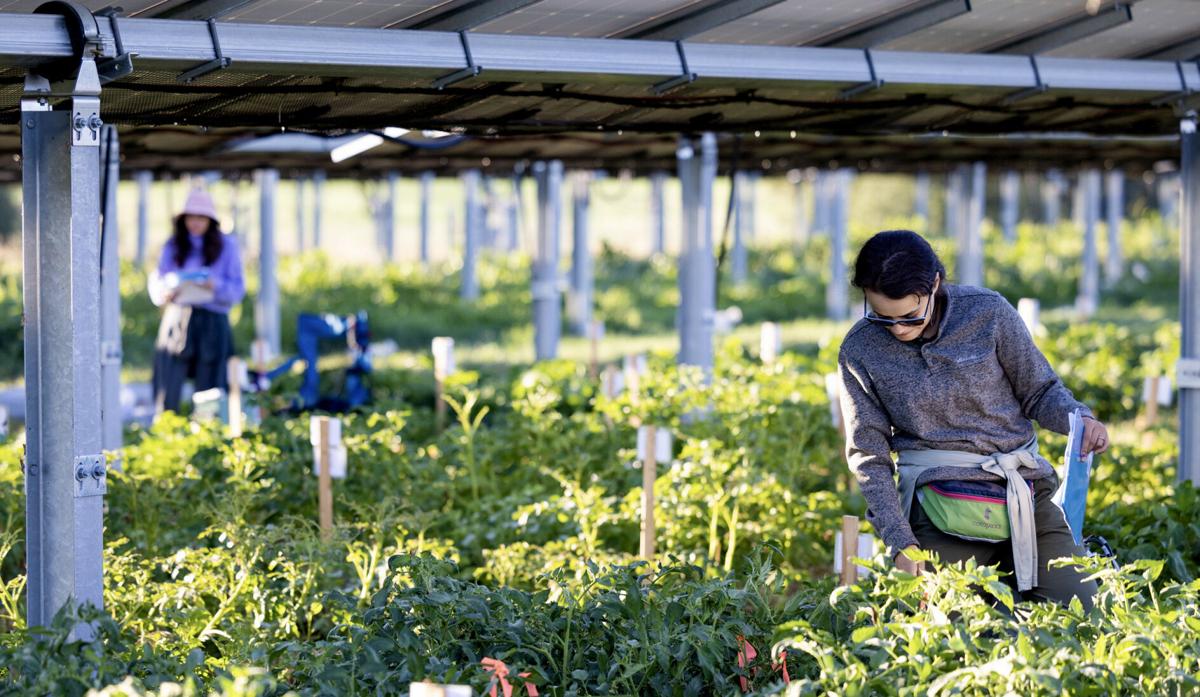University of Arizona scientists are proving that electricity isn’t the only thing you can harvest down on the solar farm.
That’s the idea behind agrivoltaics, the science of raising crops or livestock on photovoltaic energy sites, a concept has been around since the first solar farm began sprouting up in the 1980s and practiced mainly in parts of Europe and Asia.
The concept has been slow to catch on in the U.S., but now University of Arizona scientists are working under millions of dollars in federal grants to optimize agrivoltaics on solar farms:
Last week, the UA announced a three-year, $4.7 million project funded by the U.S. Department of Agriculture, to support an agrivoltaics partnership including the UA College of Social and Behavioral Sciences and College of Agriculture and Life Sciences, with the University of Maryland and three Arizona nonprofits — Tucson City of Gastronomy, the Arizona-Sonora Desert Museum and Local First Arizona. Co-principal investigators on the project are Greg Barron-Gafford, professor in the School of Geography, Development and Environment, and Gary Nabhan, a research social scientist in the UArizona Southwest Center and the Kellogg Endowed Chair in Southwestern Borderlands Food and Water Security. The Arizona Partnership for Climate-Smart Food Crops, announced Tuesday, will focus on promoting climate-smart food production practices and helping farmers reduce water consumption and carbon emissions.
In December, Barron-Gafford was awarded a $1.2 million Department of Energy grant as one of six researchers awarded grants totaling $8 million for the DOE’s Foundational Agrivoltaic Research for Megawatt Scale (FARMS) program, to support the co-location of agricultural production and solar farms, while reducing barriers to solar deployment and maximizing benefits for farmers and local communities.
Last fall, the UA was awarded just over $1.7 million by the USDA’s National Institute of Food and Agriculture, as part of a larger four-year, $10 million project funded by the U.S Department of Agriculture to study agrivoltaic systems in a variety of land types and climate scenarios. The lead institute on the “Sustainably Colocating Agricultural and Photovoltaic Electricity Systems,” or SCAPES, project is the University of Illinois Urbana-Champaign.
Barron-Gafford said agrivoltaics provides benefits for solar plant operators as well as for farmers, but many questions remain to optimize the benefits for both.
While solar operators may benefit from added agricultural revenue and the cooling effect of co-located crops — since photovoltaic panels are more efficient at lower temperatures — many are leery of the impact on solar production and equipment damage, he said.
Farmers, on the other hand, can add revenue-producing land while also extending their growing season for certain crops, as shade from solar panels reduces water evaporation from the soil while also protecting crops from frost, Barron-Gafford said.
With the USDA and DOE grants, “we are able to approach the question from both a solar-centric and farm-centric approach,” Barron-Gafford said.
On the solar side of things, the UA researchers are working to identify crops that don’t grow so tall as to shade the solar panels and panel spacing to allow operation of tractors for cultivation while avoiding damage.
For farmers, the scientists are researching crops that do well in partial shade and warmer conditions and shorter native grasses that do well in shade for livestock grazing, he noted.
The UA research will also look at how farmers can best add solar to existing cropland, including optimal spacing of solar panels, to offset their own carbon footprint.
“Between all of our sources of knowledge — farmers, ranchers, researchers, Indigenous folks — we know which plants meet these features; it’s all about designing that system,” Barron-Gafford said.

A researcher collects soil to understand “Time 0,” or what the conditions are before beginning to reintroduce agriculture to a photovoltaic array, including soil moisture, carbon and microbial community.
Sustainable communities
During an event announcing the Arizona Partnership for Climate-Smart Food Crops last week, UA and local government officials praised the project as a way to leverage UA science to help build sustainable communities.
Elizabeth “Betsy” Cantwell, UA senior vice president for research and innovation, noted that the UA is among the top schools in the nation and world for water resources research, while Arizona is one of the biggest agricultural water users in the U.S.
“Through our research and innovation and our increasing focus on this very important capacity of the state of Arizona we will look at not only our current conditions, but how do we reshape those conditions and impact the future, so that we as a state can continue to deliver as a state value to our citizens through agriculture?”
Tucson Mayor Regina Romero said the climate-smart food partnership fits with the city’s sustainability initiatives and community goals.
“This project will be vital in our efforts to address the challenges to agricultural production and food and economic security around the state and around the world,” Romero told a group gathered at a solar garden on the roof of the UA’s Environmental and Natural Resources 2 building.
Finally getting a ‘yes’
Barron-Gafford has been studying agrivoltaics — also known as agrisolar, solar sharing or dual-use solar — for years with a solar garden installed at the UA’s Biosphere 2 near Oracle in 2017.

Barron-Gafford
After trying unsuccessfully to win grants to support the work, Barron-Gafford and his team won a $300,000 grant funded by the National Science Foundation in 2019.
“We were told ‘no’ about the concept for years before we got that final ‘yes,’” Barron-Gafford said. “We saw a lot of solar going into former ag lands, but they were doing a lot of clearing off of all the vegetation that was there, and people started worrying about, what are the implications of that?”
After initial research showed solar farms created warmer microclimates in the absence of vegetation, the team began experimenting with the effect of replanting between the rows of solar panels.
Working under a National Science Foundation grant, Barron-Gafford and his student team grew tomatoes, peppers, chard, kale and herbs in the shade of a small solar array at Biosphere 2 as well as in traditional open plantings, measuring microclimatic conditions, PV panel temperature, soil moisture and irrigation water use and plant function and growth.
Barron-Gafford and his team also planted some experimental plots at several solar installations on Tucson Unified School District, where they are being used as learning labs for students.
See how the University of Arizona is researching the best ways to grow crops on solar-energy farms.
Promising results
In a study published in the journal Nature Sustainability in 2019, the UA researchers found that the shade provided by the solar panels resulted in cooler daytime temperatures and warmer nighttime temperatures than the traditional, open-sky planting system, while there was more moisture in the air.
Production of chiltepin peppers tripled, and cherry-tomato production doubled during the experiment.
Work under the new DOE grant will focus on how crop production and grazing can be conducted within existing photovoltaic plants — without significant modifications to solar design.
In three test plots embedded in a 121-megawatt solar site in Pinal County, the project team will conduct crop trials to understand agrivoltaics’ impact on water usage and crop performance in the arid Southwest.
The researchers will also host site visits with local farmers to showcase the potential of agrivoltaics.
Agrivoltaics has been practiced mainly in parts of Europe and Asia and have included three basic designs: crop cultivation or livestock grazing between stationary solar panels; solar panels mounted over crops and moved as needed for cultivation; or simply mounting solar panels on greenhouses.







